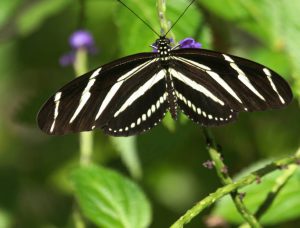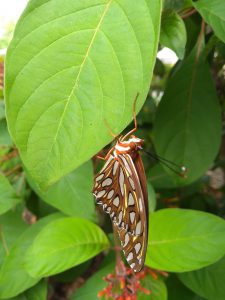Post authored by Susan Griffith, Florida Friendly Program Specialist.
Spring has sprung and with it comes many butterflies! Butterflies start out in their larval form as caterpillars of all different shapes and sizes. They like to munch on some of the plants you may have in your yard. If you see caterpillars covering your plants, put back the insecticide! Use available resources to determine which butterflies may be growing in your yard. Below are a few of the common butterflies you should expect to see growing this time of year..

The Zebra Longwing Butterfly
This butterfly is our state butterfly. It gets its name from its black and pale yellow zebra-like stripes and from its long, narrow wings. These caterpillars (larvae) like to eat different species of passionflower (Passiflora spp.) so the adults will lay their eggs on the plants, allowing their offspring an easy meal upon hatching. Their larvae are skinny white caterpillars with tiny black spots and thin, black spines. They are one of the longer-lived butterflies, living several months if conditions allow it. They are also better pollinators than most butterflies, because part of their diet consists of pollen.
The Gulf Fritillary Butterfly
 Another common butterfly you will see in Manatee County is bright orange with bold, silvery stripes underneath their wings. They also use different species of passionflower as their larval food source so they will also lay their eggs on these plants. Their caterpillars are thin and bright orange with black spines. They will live for a few months if conditions are right for them. They also require some pollen in their diets, like most butterflies that enjoy longer lifespans. As adults they, like their Zebra longwing cousin, will feed from plants in the Aster, Thistle, and Verbena families among others.
Another common butterfly you will see in Manatee County is bright orange with bold, silvery stripes underneath their wings. They also use different species of passionflower as their larval food source so they will also lay their eggs on these plants. Their caterpillars are thin and bright orange with black spines. They will live for a few months if conditions are right for them. They also require some pollen in their diets, like most butterflies that enjoy longer lifespans. As adults they, like their Zebra longwing cousin, will feed from plants in the Aster, Thistle, and Verbena families among others.
The Monarch Butterfly
The iconic orange and black butterfly (pictured in the blog cover photo) causes everyone who sees one to smile and point it out to others. There is something almost mystical about them. This is partly due to their long migration which takes many generations to complete. It is the final generation (usually the 5th generation) that is especially mysterious. This generation lives for 7 to 8 months, far longer than the other generations. This last generation is born with immature reproductive parts. It is known to travel sometimes for thousands of miles to reach a particular forest of sacred firs in Mexico where it overwinters. Millions of monarchs will cluster together on trees to keep warm. When spring arrives they rouse themselves from torpor to eat, breed and begin a journey back through Texas. This spring migration allows them to find their larval food source, the milkweed, growing prolifically. The females lay their eggs on the milkweed and die soon afterward, guaranteeing that the new generation has a good start in life.
You Can Do Your Part to Help the Butterflies
By planting some of the plants mentioned above, you can help to give these beautiful creatures the food that they need to survive and to thrive. Native Passionflower vine Passiflora incarnata and its baby sister the native corkystem passionflower Passiflora suberosa will sustain many of these caterpillars. To welcome monarchs you will need milkweeds. There are over 20 species of native milkweed in Florida. They vary from swamp milkweed (which needs very wet surroundings like a pond edge or center of a rain garden) to Pinewoods milkweed Asclepias humistrata and Butterfly weed Asclepias tuberosa (which require drier conditions). Try picking up some native milkweed at your local Native Plant Nursery and plant a few for the Monarchs. They will visit you for it!
For more information on gardening for butterflies in Florida, please visit: http://edis.ifas.ufl.edu/topic_butterfly_gardening
 0
0
